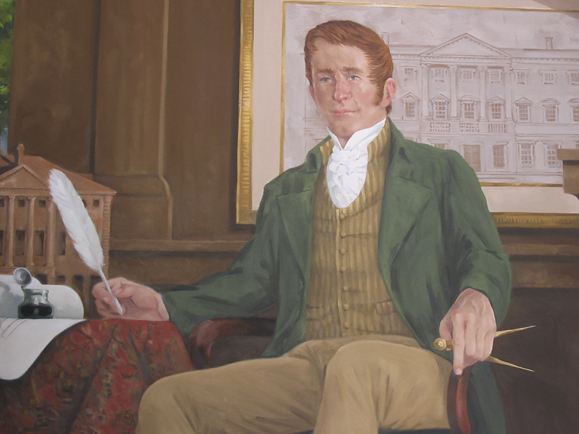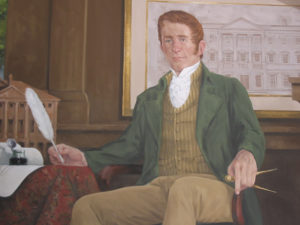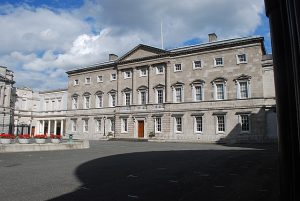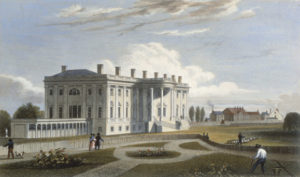James Hoban, Architect of the White House.
In 1785, a newspaper in Philadelphia carried this advertisement:
“
Any gentleman who wishes to build in an elegant style, may hear of a person properly calculated for that purpose who can execute the Joining and Carpenter’s business in the modern taste James Hoban.
Hoban was an Irishman, born in Kilkenny. George Washington never did see Hoban’s ad. But he did choose the Irishman in 1792 when it came time to build the White House.
All in all, it is easy to see Hoban as the ultimate Irish immigrant success story in young America.
So, who was James Hoban? How did he come to design the most important building for a young America? And what famous building in Dublin is the White House based upon?
Kilkenny Native
Hoban was born near Callan, Kilkenny in 1758, to a tenant farming family. A locally prominent family, the Cuffes, offered tutoring services on their estate in skills such as carpentry. Hoban took advantage of these services, and later attended the Dublin Society’s Drawing School, where his work caught the eye of Thomas Ivory, the school’s principal. Ivory also had a private design practice. It is believed that Hoban, working with Ivory, worked on the construction of notable Irish buildings such as Dublin’s City Hall and the Custom House. Though Hoban was making a name for himself in Ireland, he decided to relocate to America in 1785.
Hoban first went to Philadelphia, where he took out newspaper ads offering his services, but he ended up settling in Charleston, South Carolina. Though a seemingly odd choice, moving to Charleston proved to be a fateful decision for Hoban.
Hoban teamed up with fellow Irish designer Pierce Purcell and went on to design some private residences and worked on two of Charleston’s most prominent public buildings – a 1200-seat theater and the refurbishing of the old colonial state house as a courthouse. Still in use, a portrait of Hoban hangs there to this day. While most of Hoban’s and Purcell’s architectural accomplishments in Charleston have been lost, it was while he was working in Charleston that Hoban was introduced to General George Washington.
This certainly gave Hoban an advantage in 1792, when he entered the competition to design the new home for America’s president.
A House for the President
It’s important to remember that while Hoban was building a name for himself in the U.S., the young nation was in turmoil. True, the Revolutionary War against England was over by the early 1780s. Still, America experienced serious growing pains. It is often forgotten that under the Articles of Confederation describing “America’s first system of government” there was no provision for a president of the United States. That’s because, in the wake of the war against the British crown, it was feared that a single presidential leader would inevitably become a tyrant.
It was not until the U.S. Constitution was adopted in the late 1780s that the U.S. presidency was created. One reason people were willing to accept a president was because they knew George Washington would fill the role. The question now was: Where would President Washington – and all future presidents – reside?
Inspiration from Dublin
Interestingly, the American fear of a royal president is evident even in Hoban’s design of the White House. It is believed that Hoban’s design appealed to American government officials because it was simple and conservative, rather than ornate, which would have led many to view the White House as some sort of palace. When it came to inspiration, meanwhile, Hoban looked to his native country.
Hoban based his White House design on Leinster House, the stone residence in Dublin constructed around 1750 for the Duke of Leinster (now used as the seat of Dáil éireann). Hoban is said to have admired the structure designed by Richard Cassels, while he was attending the Dublin Society Drawing School.
Hoban played a key role in not only the design but also the actual construction of the White House, which took about eight years. Hoban was widely respected for his efficiency and problem-solving skills. So, when construction of the U.S Capitol got underway, Hoban was called in to oversee that project as well. He was also involved in the construction of the U.S. Treasury building as well as offices for the State Department, War Department and U.S. Navy.
Prominent Catholic
While he was rubbing shoulders with Washington, D.C.’s most powerful people, Hoban was also establishing himself as one of America’s first prominent Irish Catholic citizens. This at a time when anti-Catholicism was a very strong force in the U.S. It was not even legal in most states to practice Catholicism before the Revolution. Hoban, however, was a lifelong parishioner at St. Patrick’s Catholic Church in Washington, D.C., and established various aid funds, including one for Irish immigrant laborers.
Along with George Washington’s close aide Stephen Moylan (born in Cork) and Commodore John Barry (from Wexford), Hoban completed a trailblazing triumvirate of Irish Catholic power brokers in the nation’s capital.
Still, for all his other accomplishments, it was the White House with which Hoban was most closely associated. And so, when America and Britain took up arms again during the War of 1812, Hoban was called upon again when his most famous work was burned to the ground.
White House Burned
In August of 1814, British troops first marched upon the U.S. capital. Since it did not appear that they would be able to take control of the city, British officials told soldiers to simply destroy as much property as possible. Soon enough, British soldiers entered the White House, which President James Madison and his cabinet had already evacuated. With them they took as many records and valuables as possible. Most famously, Gilbert Stuart’s painting of George Washington – the man who made Hoban famous – was shuttled off to a safe place. British soldiers are said to have eaten all the food in the White House before setting it ablaze. Only the strong sandstone walls were left standing. For another decade, Hoban oversaw the rebuilding of the White House, and numerous adjacent government buildings.
The White House today, of course, does not resemble even the one Hoban helped reconstruct following the fire of 1814. The famous East and West Wings were added decades later. Still, Hoban’s influence and legacy are clear.
When they say the Irish built America, there’s no need to think only of anonymous, poorly paid laborers toiling on the Erie Canal and frontier railroads. The President, visiting dignitaries, and thousands of tourists marvel at an Irishman’s work each and every day.





Excellent piece of writing and history. I really enjoyed reading it. Thank you
They say that the English were, and are, a curse on the Irish Nation, but Catholicism is Possibly our biggest curse.
It would appear the fundamental social difference between Protestantism and Catholicism evolution is the prominence of reading.. Reading the bible was paramount in the eyes of Protestants. Protestants were compelled to teach their children to read, so as the children could read the bible. Catholic society relied heavily on the priest class to guide the masses.
Catholics did not view reading as a paramount of importance. It was viewed as a activity for the noble class and not the masses.
The history of “bible reading” is very interesting and rather simple. Catholicism is far more ancient than the the Protestant sects. There was no printing press, or available bibles outside the very rich. Stained glass windows and statues and readings of both old and new testaments were the “bible” of the masses. Those were never lost to us and remain integral to this day. All of it was lost in Protestant sects. The printing press brought the bible to everyone. It was far more needed and used by the masses of Protestants than Catholics and that is the “why” .
I am not sure if am related but I find all of this very interesting. My Great,Great Grandfather, Francis Hoban, immigrated around 1850 to work in the Savage gold mine at Virgina City, Nevada. His son, James Hoban, also woked in the mine.
It’s an excellent historical article and is well worth reading again and again.